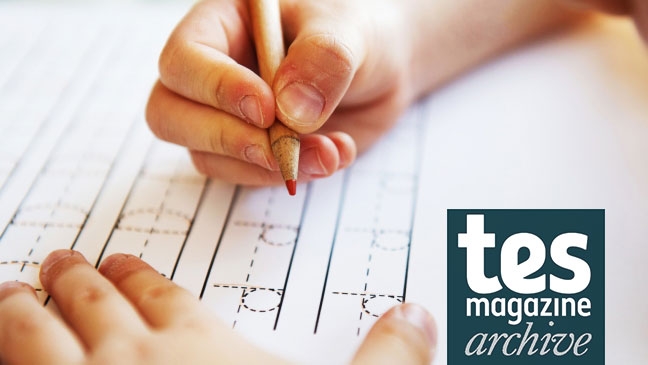
- Home
- Teaching & Learning
- Early Years
- How to teach letter formation
How to teach letter formation

This article was originally published on 9 October 2023
Learning to write names is an essential first skill to focus on in Reception. But what is the best way to teach children how to do it?
I recently started to think about this when a colleague suggested that we order some tracing paper. “We haven’t used that for years,” I exclaimed.
But, as I began to explain why, I found myself questioning the methods that we were now using. How sure were we of our current approaches?
A quick Google search led me to several interesting blogs and articles, written by occupational therapists (OTs). What I read has given me fresh clarity on some important aspects of learning to write, and what those mean for how we teach letter formation.
Letter formation: the context
Learning to write is really complex. Children face many challenges: remembering what a letter looks like, controlling their pencils and coordinating movements while they process visual information.
There are many contextual factors to acknowledge, too: a child’s age, their visual motor skills, their ability to sustain attention, their preschool experience and, most importantly, their motivation to actually pick up a pencil.
Read more:
- Why handwriting matters more than ever
- What happened to handwriting in lockdown?
- Do we really need joined-up handwriting in schools?
It’s also crucial to recognise each child’s starting points. Some start Reception not even able to recognise their name, while others can already form a version of it. A very tailored approach is therefore needed.
Through my research I found a common opinion among OTs that it takes a number of repetitions of forming a letter for a child to really embed that pattern of movement in their brain.
However, once a child has learned to misform a letter (a classic example is a circle and stick for letters like d, b and p), it takes many more repetitions to correct. This is a challenge for teachers because children often arrive in the classroom with this habit.
Should you use tracing paper?
This is where my objections to tracing paper come in. If children are left unguided to trace over letters, it’s likely they will be creating or reinforcing bad habits: tracing letters incorrectly, using the wrong starting point, moving in the wrong direction and often “segmenting” letters. They may also have a poor grip.
For these reasons, I wouldn’t have large groups of Reception children tracing or copying letters independently. First, they need plenty of guidance. The teaching needs to be explicit. We want to avoid entrenching bad habits.
Some OTs also argue that tracing with a pencil is not as effective as using fingers, as creating “motor memory” is more effective with sensory feedback.
So, taking all of these factors into account, what are the best ways to teach children to write their names?
How to teach letter formation
Practical tips for teaching children to write their names:
- Put away the tracing paper! Begin with sensory materials and fingers. We use things like shaving foam, glitter, cornflour, rice and paint.
- Approach the skill as though it were a type of observational drawing. Give children lots of time to really look at the shape of the letter before they begin attempting to form it.
- As you form the letter, talk through the motions. Most phonic schemes have some “letter patter” to help with this. Use a catchy ditty wherever you can, and encourage parents to be consistent with this, too.
- Make an assessment of each child before you plan, considering all of the skills needed for writing. Can they recognise their name? How do they grip pencils? Can they copy a shape? Can they sequence? What is their range of movement in the arm and wrist?
- Pitch your teaching to individual pupils’ motor skills. If you have a child struggling with gross motor skills, unable to cross the midline, you will need to think about the size of the “canvas” you give them to form letters on. They will need something large, such as a wall or floor space.
- Teach in small steps; some children will need to build skills slowly and will take more time to develop motor memory and remember the sequence of letters. If they are not developmentally ready (especially very young children with a long name), they may need to learn two- or three-letter sequences gradually.
- Finally, make it fun. Children don’t want to be dragged to a table to do a worksheet. There are so many opportunities for letter formation within the play environment: using sand, mud, paint, grass or chalk, for example.
Linking the objective to children’s play also helps to make the writing purposeful. Can they write a label for their Lego model or painting?
By taking the teaching to children’s play, it gives us flexibility to tailor instruction to their needs, ultimately leading to better engagement.
Helen Pinnington is the early years foundation lead at St Thomas More’s Catholic Primary School in Bedhampton, Hampshire
You need a Tes subscription to read this article
Subscribe now to read this article and get other subscriber-only content:
- Unlimited access to all Tes magazine content
- Exclusive subscriber-only stories
- Award-winning email newsletters
- Unlimited access to all Tes magazine content
- Exclusive subscriber-only stories
- Award-winning email newsletters
You need a subscription to read this article
Subscribe now to read this article and get other subscriber-only content, including:
- Unlimited access to all Tes magazine content
- Exclusive subscriber-only stories
- Award-winning email newsletters
- Unlimited access to all Tes magazine content
- Exclusive subscriber-only stories
- Award-winning email newsletters




